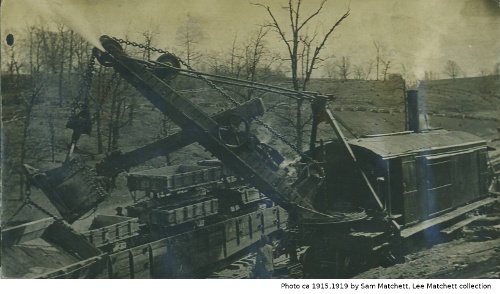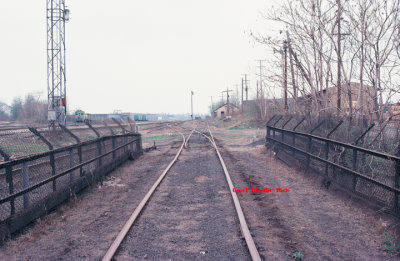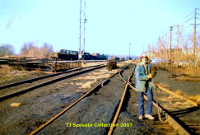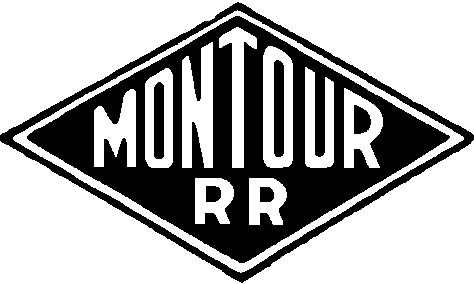Milepost 44 Mifflin Junction
By Gene P. Schaeffer
I hope you all don't mind taking a
peek back at a small section of trackage at Mifflin Junction.

Construction of
Mifflin Jnc in 1919.
As stated in the Montour RR book,
the property at Mifflin Jct. was leased from the Union Railroad. The
Montour had a small terminal there for many years where both diesel and
steam locomotives were kept.
 In
the attached scene, were looking west from on top of Delwar Road
overpass which was just below the scale at Mifflin. Each day and night,
crews arriving Mifflin Junction would divert onto Montours own trackage
that is now part of the scrap yard, pulling their train up to the scale
here the engine(s) would cut away, run around the train and shove over
the loads over the scale for weighing.
In
the attached scene, were looking west from on top of Delwar Road
overpass which was just below the scale at Mifflin. Each day and night,
crews arriving Mifflin Junction would divert onto Montours own trackage
that is now part of the scrap yard, pulling their train up to the scale
here the engine(s) would cut away, run around the train and shove over
the loads over the scale for weighing.
Car load by car load would ease over
the live rails of the scale, and from inside the scale you
could watch the weighmaster stamping the weights of each car
onto their respective bills.
The weighmaster during my time riding into and out of Mifflin Jct. was
a pleasant gentleman by the name of Gene McCuen. Gene lived in
Bridgeville and would receive his nightly telephone call from the train
dispatcher advising him when the estimate arrival time of the crew in
Mifflin.
Mr. McCuen told me many times his arrival at Mifflin usually ended up
hours before the Montour crew did and he would as best as possible,
take a "un-official" nap during the wait.
So vividly, I remember those nightly rides into Mifflin. Coming out of
Salida, the Flagman would announce the car count till the caboose was
off Montour trackage so the connection switch there could be lined and
locked back for the N&W main.
When the highball was
announced over the airwaves, the SW-9's came back to life, throttling
up restarting the train...the gentle hiss of sanders accompanied the
constant flashing of the wheel slip light, and the un-mistakable whine
of the EMDs loosing their footing echoed throughout the engine cab.
Years after that last train of coal was delivered to Mifflin Junction,
now living just 2 blocks up the street from the crossing on the Mifflin
Branch, I would take the dog for a walk and re-explore that Mifflin
Branch trackage, stopping occasionally to examine the burn marks in the
rail head near the end of that tangent coming out of Salida, where
those SW-9's from years earlier, sometimes with me aboard, would leave
permanent scars that only a few would understand.
30 years and millions of tons of steel coil, coal, auto parts,
miscellaneous freight, coke and a wide variety of newer EMD products
later, those scars left behind on the rail head by those elderly SW-9s
have been gently erased. Here and there a few rail burns still remain,
but today who would understand. Only a devoted few understood the
significance of keeping record back then, even at such a young age.
Those trips to Mifflin during those God awful night time hours of the
early 70's were offset by thrill and adventure of being part of the
Montour RR. The feeling...the participation...the experience
of being aboard those multiple unit consist of SW-9's...with
40...50...and as much as 89 loads of Mifflin coal...out on
N&W's Mifflin Branch...the roar of the diesel engines... the
cab atmosphere...the darkness of the night time
hours...seeing homes and businesses fast asleep as the Montour moved
another train load of Champion Coal closer to destination...
There was always one household inside that last mile coming
into Mifflin, that no matter what hour it was, the bedroom television
reflected itself outside bringing attention to the rider back in the
locomotive consist. I often wondered if the train crews found amusement
as I did, finding themselves looking for that same residence to see if
that same t.v. was still on, trip after trip over the
N&W into Mifflin Junction.
Arrival at Mifflin...engines cut away and back through #14 track to the
rear of the coal. Sometimes the train had to be cut in half for
weighing. With the engines behind the caboose and each car bled off,
weighing would begin.
Standing in the doorway of the white brick building, directly above the
doorway a black metal plate, paint faded in time, identified
this place as
Mifflin Jct.
A few car lengths to my right, a darkened figure gripping a railroad
lantern, cuts away each car load of coal for the trip over the scale.
Gene McCuen paced with experience, jockeys each waybill into position
for stamping. Those railroad cars, just a few feet from the buildings
threshold where I stand, are frightening in size to a teenager as each
eases itself over the scale.
To my left, where the attached photo was taken from, a gathering of
MONTOUR and B&LE hoppers loaded with Champion coal, rain down a
shower of coal from each cars coupling after the trip over the scale.
The photo was taken 4 years after the last Montour coal train was
delivered to Mifflin Junction. On the ground in the photo, witness the
excess Champion coal still there from all of those hard couplings....
Delwar road overpass has since been retired. The Mifflin scale is a
distant memory. The red brick building over to the left is now a Target
store, the Union RR switchers are no longer kept at Mifflin...but the
Memories of the Montour Railroad delivering Champion coal to
Mifflin Junction linger on with time.
Near
the End - Tim Sposato
Mifflin Jct was a fairly
busy point up until steam was retired. The 1940's saw up to 5
locomotives assigned to the assortment of mine runs and locals that
would originate there. By the early 1950's only 3 engines were used
there, since the mineswere winding down and coal runs reduced. The
local would also be eliminated as the diesels took over the headends.
 There
was a locomotive inspector, laborer, hostler and mechanic to make the
running repairs needed. When an engine came due for its
monthly boiler wash, it would be traded with a fresh engine from Mtr
Jct. allowing it to return for heavier repairs and a washing.
Mainly small repairs could be done here. The laborer would do all the
menial jobs including loco cleaning & coaling, caboose
supplies, and any other detail assigned by the other employee's.
There
was a locomotive inspector, laborer, hostler and mechanic to make the
running repairs needed. When an engine came due for its
monthly boiler wash, it would be traded with a fresh engine from Mtr
Jct. allowing it to return for heavier repairs and a washing.
Mainly small repairs could be done here. The laborer would do all the
menial jobs including loco cleaning & coaling, caboose
supplies, and any other detail assigned by the other employee's.
Several corrugated buildings with coal stoves for heating housed the
office, tools, oils and other support material required for the steam
engine maintenance. There was a coaling conveyor to
load the tender bunkers and a small homemade water plug to
fill the water. The coal was fed onto the conveyor by manual
shoving most of the time.
There also was a small bunk house, work and storage sheds to service
other equipments and several MRR owned yard tracks in the
Union yard. This would include the car inspector and his parts
& tools. Some train crews would report each day for
their call, while others opted to use the bunkhouse and going home on
days off. I suppose depending on their travel distance and
ownership of an automobile. Also the scalehouse had a clerks working
there for both the MRR & PWV. Each RR provided their own clerk
up into the early 70's.
The bulk of the trains MRR handled were loads of coal and empty
hoppers. The Union would pull the empties into the receiving track and
pull loads out. The switching was minimal by the MRR,
occasional bad orders, and other than coal equipment would show up for
the smaller MRR customers. MRR would move steel mill owned
equipments from Mifflin to B&T, this could be slab gondolas,
coke hoppers, ladle cars for repair or even scrapping. This
type of movement continued to November, 1975, when the last train out
of Mifflin were a handful of cars destined for B&T.
The sights and sounds of this yard would have been enjoyable, as the
Union was always making switch moves round the clock, add in the PWV
trains, the rails would have been shiny all the time. Several older
employees spoke of the glow in the skies to the SW as the Union dumped
slag along RT 51, the mills to the NW added more, along with the mills
to the North and Pittsburgh to the NW.
Night was far from dark in Mifflin yard. Also the sounds of the
B&O mallets working hard up the grade along Streets Run on the
"Pike" was frequently heard in the clear night air.
Not much is left in
Mifflin now, two bridges over the road has been scrapped, the
scale house leveled, as the lumber yard expanded. Its hard to find
anything remaining of the servicing facilities now, in the 70's
evidence of the buildings still existed, now removed. The loaded yard
tracks can still be found, mostly in their original location, the empty
tracks are gone.
I walked these tracks a few months back, reminiscing their glory days
of supporting the weight of loaded hoppers, now covered with coal,
weeds, trash and small trees. The rails, corroding by the
coal's sulphur, heavily scaled, rusting
slowly away. Sections are severed, rails bent or
broken by heavy equipment that removed most of the Union RR tracks.
Slowly disappearing....most likely soon to be gone......
Attached is a shot of me in Mifflin Jct. The last train had departed
the 3 months before, Section Gang Two was sent to Mifflin to
remove badly needed 90 lb switch points and switch machines
for other locations. I was pulling spikes on the first switch, off the
lead for the loaded yard, when Foreman Schmidt asked to use my
camera. Behind me are the bridges over the road, the
scale house, behind my helmet. Mounted on the pole across from the
scale house is the "Traffic Light" used to signal the engineers of the
weighing movements by the clerk, prior to use of radio's.
The spotlight tower,most of the Union Yard, scales, lights,
bridges, .....gone. Those few rails in front of me, amazingly
remain.... for now......
The east end was an busy, exciting place, even when we were growing up,
some sounds and night time glows remained for us to
remember.....enjoying the friendliness of MRR crews and avoiding the
Union RR bulls.
Tim Sposato
 Montour Railroad
Montour Railroad 